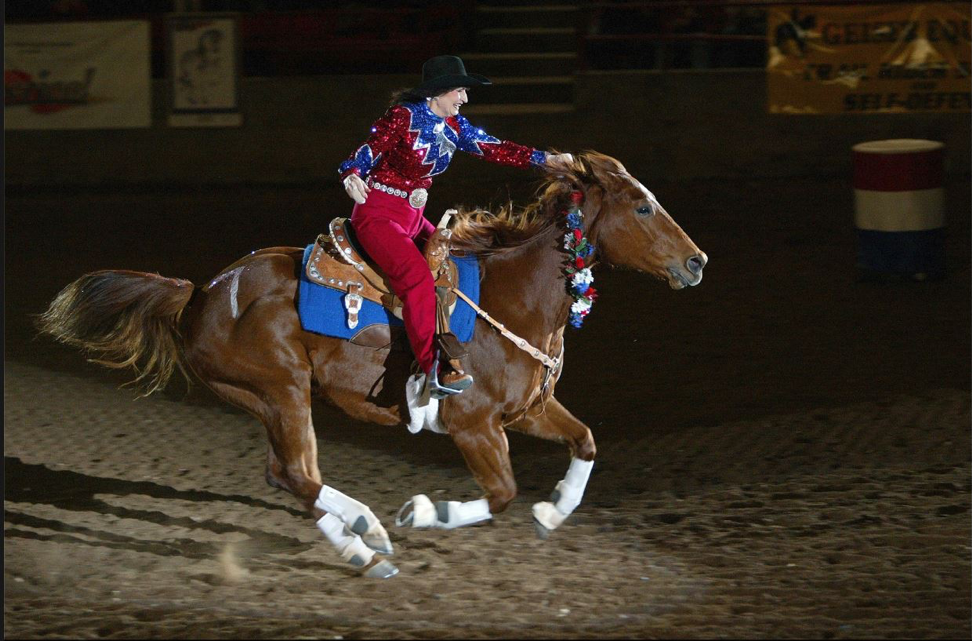By Martha Josey and Ashley Schenk
Barrel racing is a guiding contest. As riders, it is our job to position our horses to make the best turns possible and hustle home. However, what a lot of barrel racers don’t realize is that this consistency is created in slow work.
Through my career running barrels on the pro circuit and especially at the National Finals Rodeo, there was one huge goal that I always had in mind. I wanted my horse trained to run an efficient pattern and never hit a barrel. To achieve this goal, it takes a lot of consistency and a lot of basic training.
When I run my horse, I want him to make the same run every time. I like to teach my horse where to rate, and to keep its forward momentum in the turn and so I can guide around the barrel.
The First Barrel
This is the money barrel—a good turn here will really shave off time in your run. During slow work for the first barrel, I like to make sure my horse has rate on his mind. “Stop offs” are a great exercise to achieve this. I approach my first barrel and stop my horse several times with the last stop right where my tracks cross at the first barrel, which is where I want my horse to rate. From there, I teach my horse to shape off my inside rein and leg and keep his forward momentum in his turn. I cannot express enough how important it is to shape your horse up at the barrel. These exercises are great for developing consistency at a walk, trot or slow lope.
One key in my training at the first barrel is to also make sure my horse slightly overturns this barrel. This helps your horse to pick up the correct lead going to the second barrel and helps put you in the proper position for your turn.
The Second Barrel
The second barrel is the most hit barrel out of the three turns for a couple of reasons. The first reason could be that you are out of position leaving the first turn. This is where overturning the first barrel will benefit you and your horse. Overturning lines you up with the second barrel correctly so that you are running in a straight line to the side of the second barrel rather than a big figure eight.
Secondly, a lot of horses will anticipate the second barrel because they are running straight at the fence. To correct this, it can be helpful to lope straight past the barrel to the fence, because this will take the anticipation out of him. This will keep your horse focused on you rather than anticipating the barrel. If you change up his pattern, he will be more responsive to what you are telling him to do. This exercise should be effective after three or four times. From there, go back to slow-working your basic barrel pattern.
Remember to work your second barrel the same way that you worked the first by shaping them with your inside rein and inside leg, rate, then pull towards your pocket with your inside rein. Use your outside rein and outside leg for balance.
The Third Barrel
For many horses, the third barrel is the weak barrel. Emphasize all the slow work basics as you did on the first and second barrels. Many third barrel problems are caused by running a loop instead of a straight line to the pocket at the third barrel. To correct third barrel problems, go deeper into your turn—straighter, longer. In slow work, make the horse go deeper to the third barrel. Ride two-handed and use your legs.
Keep Your Riding Consistent
To get your horse consistent, go back to basics. In slow work, you can show your horse all the basics and how to do everything correct. Feel is so important—know every move your horse is making. Let your horse feel you. Be in the ‘go’ position when you are running and the ‘whoa’ position in the turn. Constantly be working on your hands to have a soft feel and riding correctly with your body to create consistency through muscle memory. Remember, barrel racing is a guiding contest—the barrel racer who knows how to guide will know how to win.
For more information on training, conditioning, motivation, seasoning, and hauling, read my book “Run to Win with Me.”




